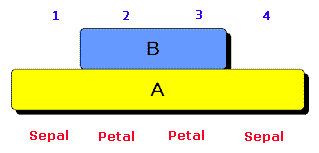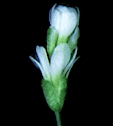| The Class C Floral Organ Identity
genes are necessary for the proper development of the stamens and carpels normally
found in the third and fourth whorls of the flower. The Class A and C activities are
mutually antagonistic, meaning in Class C mutants, the Class A activity expands to include
the two inner whorls. |
|

|
AG is the only known Class C gene and
is required for normal stamen and carpel development. |
| In addition, AG is required for
determinacy, such that ag mutant flowers are indeterminate and continue to
elaborate new whorls of organs, giving rise to the "flower within a flower"
phenotype. In agamous mutant flowers, the 3rd whorl stamens are replaced
by petals, and the 4th whorl carpels are replaced by a new flower. Thus, the
generalized phenotype of ag mutant flowers is (4 sepals, 4 petals, 6 petals)n.
|

agamous mutant
|
| Expression of AG RNA
in wild-type flowers occurs in the two inner whorls from stage 3 onwards, although the
accumulation of AG RNA expands to include all four whorls in apetala2 mutant
flowers. AG activity is responsible for preventing the accumulation of AP1
RNA in the two inner whorls. AG is a MADS-box gene and thus likely encodes a
DNA-binding transcriptional regulator. |
| Selected
References: Bowman et al., Development
112, 1-20, 1991
Drews et al. Cell 65:991-1002, 1991
Gustafson-Brown et al. 1994. Cell 76: 131-43.
Yanofsky et al., 1990.. Nature 346:35-39. |